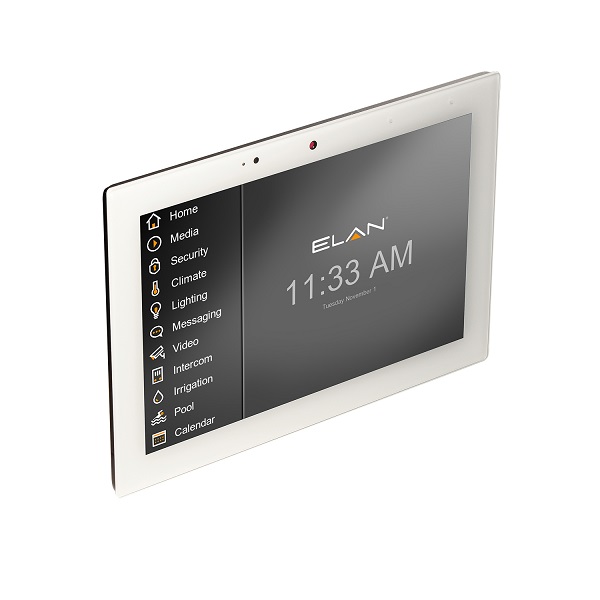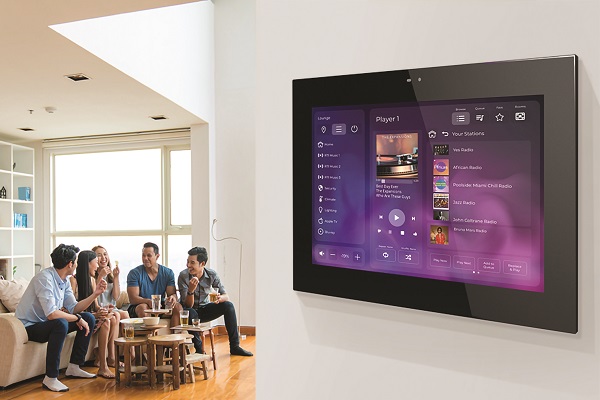Not just a brick on the wall
A good control pad or switch does more than just look stylish – it gives users immediate control over their home’s technology. Anna Hayes learned more about these tactile control methods.
What’s the one thing you want to be able to do after installing a load of technology in your house? Well, control it of course, and the good news is that there’s a multitude of ways to do just that.
ADVERTISEMENT
I’m sure most of our readers will remember those scenes in old 80s movies where the rich playboy claps his hands and the lights go on or off – bonus points if anyone ever installed one! But there’s always been a slightly showy feel to control – the reality is far more functional, with a side of aesthetics thrown in.
While voice is the format that makes everyone daydream about having a J.A.R.V.I.S. style AI-assistant, it’s still in its infancy (and needs to understand accents). By far and away, the most natural interface is still touch.
And that’s where switches and wall panels come in. Because humans are also creatures of habit and, if they’ve always used a switch to turn on the lights, maybe a variation on that theme is better than reinventing the wheel.
Functionality
At its simplest, a wall panel or switch allows the homeowner to change the settings on their various tech, trigger scenes, respond to alerts or power up devices as per their preference.
Ivory Egg’s national technical and training manager, Simon Harvey, explains: “The basic function of a wall panel is to control a load or number of loads within an automated house. The controller is a form of presence for anyone entering the room.”
Although he does point out that sensors within these units are increasingly starting to play their part: “A motion detector is another input into a system that can make a decision for you if it recognises that you are present.”
Amber Technology’s brand manager for RTI/KASTA, Gerrit Ryan, adds that a wall panel, or variation thereof, “provides convenient system operation without having to pick up a mobile device or remote control.
“The wall panel is always connected and ready for system control. It doesn’t have to be small enough to fit into your pocket; it can have a larger screen with bigger buttons, with less scrolling and page-flipping. You wouldn’t remove all your light switches to control your lights exclusively with phones or tablets, right?”
The alternatives
While there are alternatives to dedicated wall panels, there are some caveats with each.
Todd Norberry is the APAC training and support manager for Nice North America LLC and he points to something like a remote control that can offer extensive functionality and reliable feedback:
“A tactile remote control will enhance the user experience and interaction with their control solution, however ensuring the remote is regularly charged and/or hasn’t been accidentally left in another room when needed can be the downside when compared to a touchscreen interface that is always in a fixed location and doesn’t require charging.”
He says that iPads, iPhones and Android devices can be used as an alternative, however there are challenges with these solutions where the user experience and overall reliability of the control solution can be compromised through the devices universal/multi-purpose design. Sometimes, Todd says, a decision will be taken (whether by client or installer) to use an iPad instead of a dedicated wall panel, often off the back of cost issues.

A dedicated control touchpanel simplifies home control in an automated space, providing always-on operation and access to the system (image via ELAN)
Straightaway, there’s an issue with that in the fact that iPads/Tablets need regular charging, or the kids could be playing games on the device in another room when needed, however that pales in significance when you look at how such a solution can affect a system and user experience.
Todd says: “With an iPad, if it’s not already being used for other purposes at the time, you must select an app, wait for it to launch, then give it time to connect before being able to use it. If you close out of that app, it disconnects. Whereas with a touchscreen, you walk straight up, it’s always connected and is ready to go, this is especially important when time sensitive events like an intercom call are triggered”.
You also potentially avoid the situation whereby an Apple or Android update may render the entire the system unusable if using these devices exclusively.
Todd explains: “While rare, let’s say a tablet manufacturer releases an OS update that the customer initiates when prompted by the device. If this update makes security changes, there is a risk it may inadvertently impact the accessibilities of features the control system app requires to operate correctly on this device. If this was to occur, the customer will be inconvenienced, and it may translate into a service call being needed to rectify the symptoms, which is a variable outside the control of the installer.” By using a dedicated touchscreen, any updates are controlled by the installer and are thoroughly tested by the manufacturer to ensure there is minimal risk of incompatibilities or outages leading to a negative user experience.
Gerrit concurs, saying that, in addition, tablet manufacturers have relatively short model cycles, and you could end up buying a dock that will not fit any future upgraded tablet: “A control system’s own touch panel will typically be powered by the network rather than batteries, and you have a reliable hard-wired Ethernet connection to the system rather than WiFi.”
The ol’ switcheroo
One other option that maintains the reliability of a wall panel but simplifies an automated space even more is the simple switch – what’s so impressive about that, you might say?
Simon feels that ‘less is more’ when it comes to automation and that’s why they look at very functional strategies that can cater for houses with multiple inputs and outputs. He referred to one incident where a client said they would need 12 to 14 buttons on a switch. He subsequently explained that you wouldn’t adjust 12-14 lights every time you came into the house and, in any event, a lighting designer would have designed the setup in such a way that they would all be used in different ways, in a variety of scenes.
“The way a switch works is quite simple – as you press it, it turns a scene on or off, depending on what you want. And this way, you can have the perfect settings for the time you need it. It’s adjustable by customer or the designer but it’s a way of controlling many things that are built into these modern homes.”
Again, sensors are pulling their weight here. As Simon points out, there are switches that can recognise what’s going on in a room at all times and act accordingly to ensure that the room is always set to the way the user needs it.
Simon remarks: “People don’t want to see multiple attachments to their wall if they can get everything in one switch – we call that wall acne – so, the more functionality or properties that we can get into those switches, the more efficient we are on the upfront cost and the install but also, the more we can deliver functionality-wise.”
Looks the part
However, these days, it’s not just about the technology working efficiently, it’s about looking good as well – we’ve seen things like TVs hidden by picture frames, mounts that disappear into the floor or ceiling with the devices attached, and lots more in the area of aesthetic AV.
Gerrit says: “Many of today’s wall panels offered by control system manufacturers are styled to suit modern homes and look like a purpose-built product rather than a tablet in a mount.”
Simon feels that architecture and interior design influences have a role to play in this, pointing out that previously, the only switches and panels we would have seen would have been electrical components. Nowadays, these panels are more of a fixture and Simon feels that automation is getting more recognition of where lies in the industry.
“There are two types of people – you either want them to blend in, and not see them at all, or you want to put them on display and show them off because they look good.”
But in terms of the former trend, Simon says they are already seeing products that can be placed behind walls or under tiles and you just have to tap a wall or your benchtop – invisible switches, essentially – the only problem is remembering where exactly they are!
In the future
As with any technology, the functionality and form of wall panels and their contemporaries is constantly evolving.
For Todd, who works with ELAN systems, one of the biggest updates they have seen is facial recognition built into their touch screens, primarily for user personalisation.
“We’ve had facial recognition in our touchscreens for nearly three years enabling the touchscreen to identify the user in front of the touch panel. When this occurs, the touch panel dynamically adjust the user interface options to align that specific user’s preferences including quick select options for pre-saved personal music playlists and TV station, along with personal lighting, HVAC scenes and event triggers in an easy to access flyout. While a feature like this extends to potentially unlocking a locked touch screen, this is not a primary security feature enabling access control, etc.”
Todd suspects that as these technologies mature, we may see more emphasis on a personalised user experience that could include displaying personal streaming service accounts, controlled access to viewing areas on camera feeds and multi-factor identification to expand security integration.
On the other hand, Simon is anticipating a big kick from the maturation of artificial intelligence:
“I can see a world, 10 to 20 years from now, where’s no wall switches at all. It’s a long way off but I see AI enabling the home to know what you want and to do it before you even have to tell it to. But people are control freaks, they’re not happy unless they can control something which is fine. At the moment, we can offer complete control or something that’s really automated.”
For now though, the humble touch panel is here to stay.
-
ADVERTISEMENT
-
ADVERTISEMENT
-
ADVERTISEMENT
-
ADVERTISEMENT

